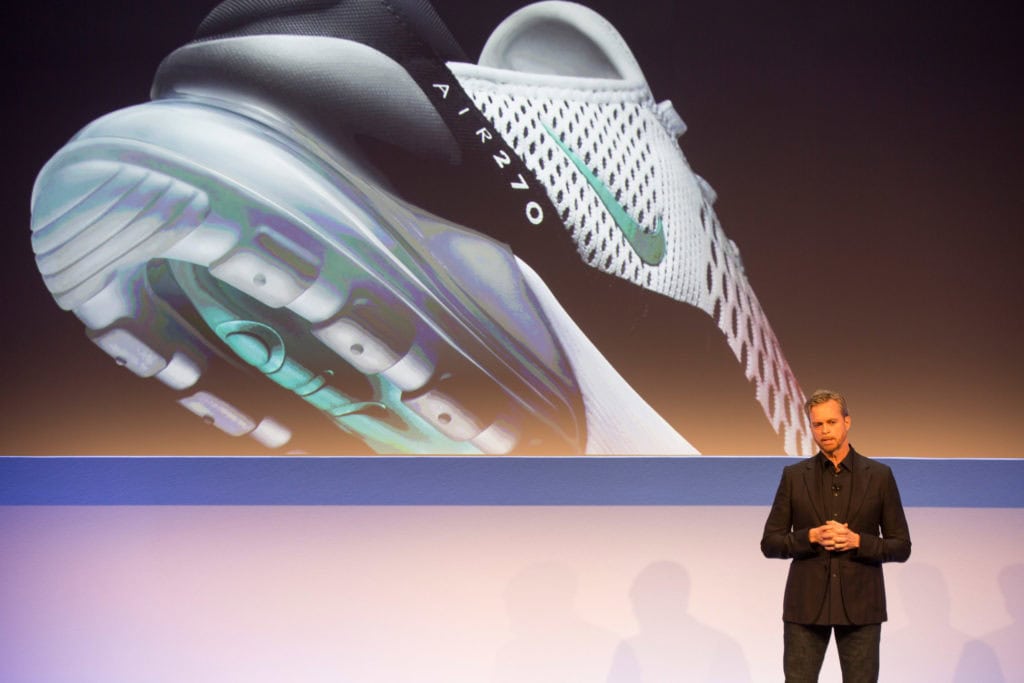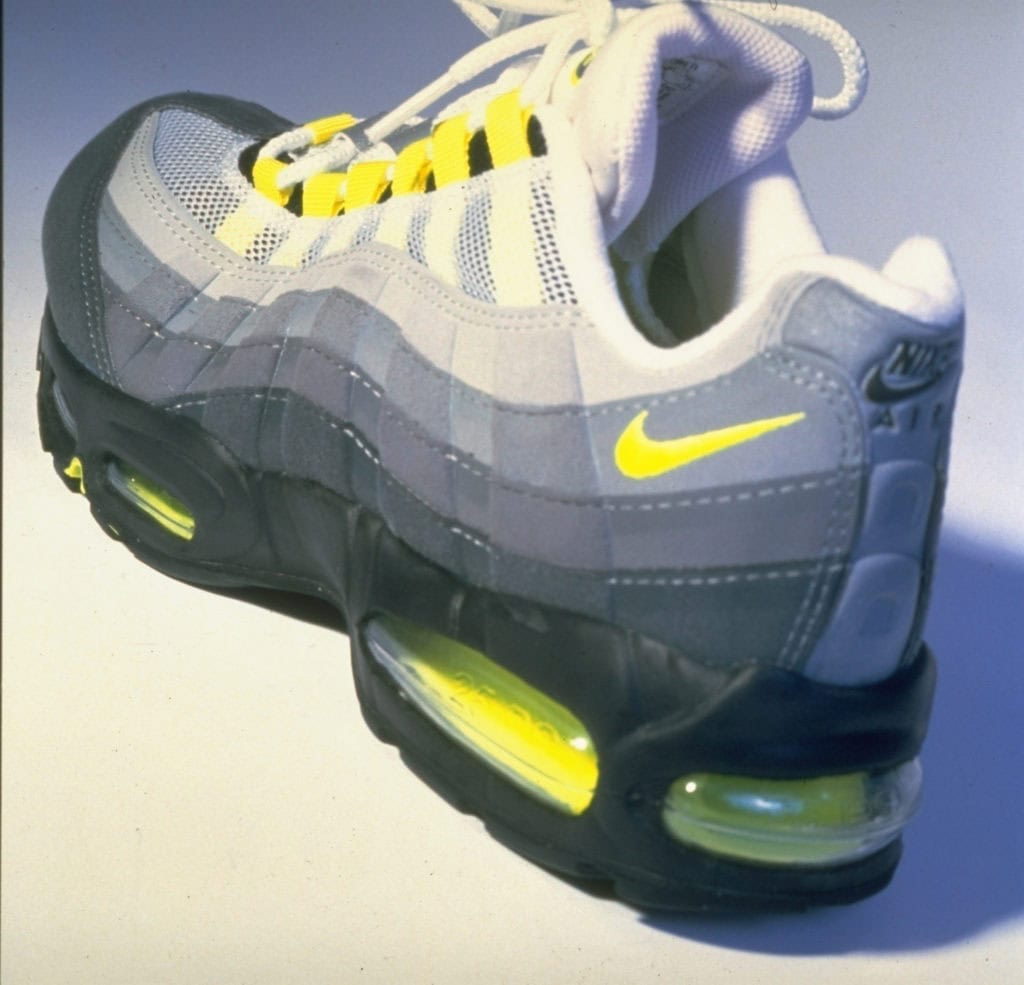For 35 years and running, Nike’s exposed cushioning system has spun off into a franchise so far-reaching it has its own holiday. This is how Air Max breathes life into Foot Locker’s billion-dollar business.
For centuries, March 26 was a nondescript date at the start of spring.
Wardrobe choices and retail rendezvous were only influenced by the weather outside or one’s own cash flow, with no context for what an individual should wear or buy. In 2014, that all changed when a Beaverton brand named Nike had the audacity to create a celebration of, well, itself.
Famously, March 26 became Air Max Day: a festivity steeped in shopping and social media posts portraying fans wearing their favorite Swoosh-stamped sneakers often of the retro running variety.
Despite debuting less than a decade ago, the advent of Air Max Day has become big business for Nike and its wide range of retailers.
At the top of that stockist food chain is Foot Locker. Recently, erroneous reports suggested that Nike was pulling products out of Foot Locker stores, where workers rock referee shirts and sell the most popular sneakers on the planet.
On Air Max Day 2022, that idea couldn’t be further from the truth. Nike is instead leveraging Foot Locker as its key player in the prominent product-hyped holiday.
A Legacy Like No Other
In 1981, architectural student Tinker Hatfield literally pole-vaulted his way into a job at Nike.
Having competed on the track team at the University of Oregon, the design student took the same daredevil approach he had in sports to breaking and thus rewriting every rule at the athletic supplier.
Around the same time Tinker created the category of cross training and was asked to keep Michael Jordan from leaving the brand, he happened to catch inspiration from a structure in France. Famously, the Centre Pompidou in Paris was as irreverent as architecture could get, exposing the guts of its foundation for all onlookers to see.

Energized, Hatfield found it proper to expose the infamous Air cushioning Nike had long used in its sneakers yet never put on full display. Despite deep desire not to do so, Nike released the revolutionary Air Max 1 running shoe in 1987 — giving the world a window into what really propelled racers in Oregon.
From there on out, Air Max was an absolute hit.
Over the course of the 1990s and 2000s, annual Air Max models made waves in the world of running with the visible technology turning the entire industry upside down. The performance pairs gained favor in the realm of lifestyle, fancied for fashion by consumers at Foot Locker locations around the world.
This proved particularly true around the turn of the century, when 1998’s Air Max Plus proved so popular that Foot Locker locales across the pond had to stock it for years on end despite design direction moving forward in the U.S.

“The Nike Air Max Plus, a.k.a. Tuned Air, is such an important shoe in Europe,” Foot Locker Global Chief Marketing Officer Jed Berger told Boardroom. “The cultural meaning there is totally different there than the U.S.”
Nike realized that the Air Max itself was not just a technology but rather a franchise within a world-beating franchise under the Nike umbrella. By leveraging local tastes and economies of scale seen at Foot Locker, the Swoosh could keep certain classics hot at retail on one side of the world while touting a new silo simultaneously in the other hemisphere.
Now living in an era of the internet and social media, where all trends are tracked and no secret is kept, Nike and Foot Locker are moving units of Air Max at a faster rate than even Hatfield could’ve imagined.
Cash Cow
Air Max technology had its moment in 1987 upon hitting the market. However, one could argue it’s even hotter roughly 35 years later.
Months ago, NPD’s Matt Powell reported the top-selling sneakers for the calendar year of 2021. Not only were four of the top-10 models named Air Max sneakers, but each Air-assisted style was also sold at Foot Locker.
“We have more Air than anywhere,” explained Berger. “The technology is in so many of their products — both heritage and new.”
Amongst the athletic industry’s top-selling shoes in 2021, the Nike Air Max 270 reigned supreme.

Introduced in January 2018, the Air Max 270 was touted as the brand’s first “100-percent lifestyle Air shoe,” leaning all the way into casual appeal. Classic designs like Hatfield’s acclaimed Air Max 90 not only still make the top-10 list in 2021 but also inspire the modern takedown Air Max Excee, also on the list. But the 270 is a triumph in unadulterated intention.
For years, the Air Max franchise was sold as the brand’s most magnified approach to performance running. By the mid-2000s, serious racers had left behind the bulky Air-assisted shoes in favor of natural movement models and competitor brands.
In that same era, revered retros such as the Air Max 95 and Air Max BW were catching wreck in the lifestyle lane, making vintage running shoes celebrated by sneakerheads.
Today, not only is every individual a self-proclaimed sneakerhead but also into aesthetics like never before. Because of this, Nike has an audience ready to consume Air Max models old and new that are never meant for anyone to actually run a mile in.
In turn, Foot Locker sees incredible traction from Air Maxes ideated in the ’80s and ’90s to ones recently rendered for retail.

“VaporMax and 270s do incredibly well,” noted Berger. “Air Max 90s, Air Max 1s, Air Max 95s, and Air Max 97s are icons in sneaker culture and have been a part of our business since they first came out.”
Air Max is as hot as ever for both Nike and Foot Locker. In fact, Nike has even gone as far as turning March into Air Max Month.
While it is true that the big brand is doing more direct-to-consumer sales, it’s also true that they’re leaning on Foot Locker to keep the chase around Air Max alive. Because of the breadth of Foot Locker stores across the country and around the world, the race to get retro runners is more competitive than ever.
The Bubble Isn’t Popping

There was a time when wanting old sneakers was a hobby one could only enjoy through online forums or Craigslist classifieds.
Over the course of the 2010s, sneaker culture became mass culture with Nike and Foot Locker right in the middle of the surge. For Berger, the buzz around retro running shoes hit a fever pitch in 2017 when Nike revived a pair of classic kicks celebrating their 20-year anniversary.
“The Silver Bullet Air Max 97 was a real moment,” Berger said of the Air Max 97 retro release. “That took a life of its own.”
That same year, Nike released its all-new Air VaporMax platform. Removing the molding of a midsole and instead exposing the Air bubble so that it consumed the entire footbed, it was Hatfield’s homage to the Centre Pompidou in even bolder fashion.
“The polarizing thing is usually the good thing,” Berger said, describing new Nike designs.
Since going retro and futuristic in 2017, all Air Max models continue to crush at Foot Locker.

“Thank goodness I can tell you both,” Berger answered when asked whether classic or contemporary sells better. “Honestly, it’s true. It tends to be that different heritage silhouettes get hot at different moments, but Air Max 1s, Air Max 90s, Air Max 95s, and Air Max 97s never go out of style. They’re just staples in the culture. But when you bring something new like VaporMax or Air Max 270? It tends to invite a new audience into the Air Max family.”
Seen by both the holiday turned into a month and the major mark Air Max makes on industry-wide sales, it’s safe to say that audience Berger speaks of is only getting bigger.
Because of the breadth of models, Air Max occupies almost every pricepoint at Foot Locker when considering sizes and styles that resonate across the spectrum. Berger calls the accessibility of Air Max “pretty democratic,” which proves true when given the great variance between the $75 Air Max 90 Slide all the way to the $210 VaporMax Plus
“Air Max is such a steady and strong part of our business, always,” said Berger. “The timing of March is perfect because it lives as its own moment. It certainly accelerates sales, and there’s nothing else like it in our industry. It’s continually huge.”

Over the years, the Foot Locker family has lived as the exclusive retailer for limited launches such as 2018’s De’Aaron Fox Air Max 1 to recent releases such as the “Evolution of the Swoosh” Air Max collection.
While March 26 might mean a lot to Air Max fans, trust that the entire year is a major event where Foot Locker is concerned.
Better yet, don’t be concerned about access to Air Maxes at Foot Locker changing any time soon.
“The relationship with Nike is terrific,” Berger confirmed. “Air Max is, has always been, and will always be a staple of sneaker culture and Foot Locker. I truly believe it will always be significant to the consumer.”